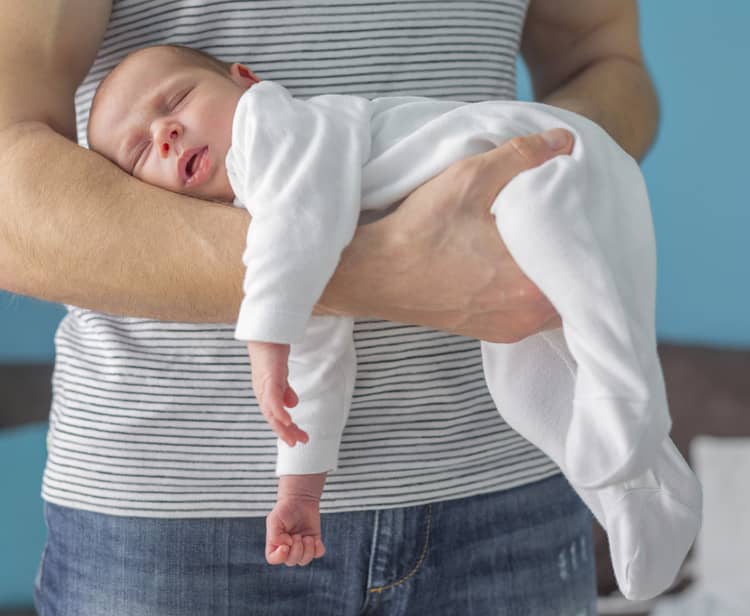
Positioning a newborn or how to properly position a baby
During pregnancy, many women also experience unpleasant moments and feel that anything they do can harm the developing fetus. After the baby is born, this fear can very easily intensify, because the baby is no longer protected from the outside world and its influences by any protective covering, as was the case in the mother's body. The postpartum period is characterized by moments of uncertainty, when mothers question every step in terms of the proper development of their child. One of the many areas of baby care that cause these unpleasant feelings in new mothers is the correct positioning of the newborn's head.
In what way and for how long should the baby be positioned, how does this activity affect the proper development of the child, but also what positions are suitable for the newborn, or we summarized the inappropriate ones in the following paragraphs of our article.
The importance of positioning the newborn
Slight deformation of the child's head, for example in the form of lying down, can already occur during pregnancy, but more often it is the result of a more complicated birth, which requires the use of obstetrical tools such as forceps. When trying to help the mother push the baby out of the birth canal, evident traces of the use of such forceps remain on the newborn's head, mostly in the form of bruises or slight bruises.
However, the resulting deformations of the child's head will disappear after some time, and the helping factor is precisely the placement of the newborn in the correct position. However, this act is important for every baby, regardless of how it was born.
The reason is the "soft" skull of a newborn, the growth of which is characterized by its speed, while the fact that small babies have certain limitations in turning their heads and sleep most of the day also takes into account. If all these factors are combined into one equation and a variable is added in the form of the parent's indifference to the correct positioning of the newborn's head, significant deformities of this part of the child's body can occur.

How to position the baby?
Positioning of a small child is required from birth. As we mentioned above, in the first months of their life, babies have a very low range of head movement to the sides, which can prevent the proper growth of this very sensitive part of the body of newborns. Therefore, it is necessary for parents to always put their baby in a different sleeping position. For example, if they let him lie on his back, it is very likely that the head will fall in the back, which is mostly called symmetrical lying. On the contrary, asymmetric lying down is at risk when the baby always sleeps on the same side.
In such cases, the baby's head flattens on the side on which it usually sleeps. It is important to remember that the baby's skull is very flexible after birth, which leads to its potential deformation due to the wrong position, regardless of the environment in which the baby sleeps.
In the interests of the proper growth of the baby, parents are therefore responsible for the regular positioning of their newborn, which consists in constantly changing the side on which he sleeps. It is advisable to change the sides on which the baby sleeps once every 24 hours. This means that one day he can sleep on his right side, while the next day it is necessary to position the child on his opposite side.
When positioning the baby on its side, it is necessary to prevent the baby from turning over on its stomach, by placing it on its side at a moderate, approximately 45-degree angle (never 90 degrees!) pillow for positioning the baby. An ordinary pillow or duvet can also be used, but they should be adapted to the purpose for which they are used.
In the event that the baby visibly prefers one selected side of the head during sleep, it is up to the parent to perform the correct positioning, which prevents the favorite "sleeping" side of the baby's head from lying down.
In most cases, it is necessary to properly motivate the child to lie on the non-preferred side. This can be achieved by using a favorite toy, rattle or other sound factor that will attract the child's attention to the side on which the parent wants to lay him. If he falls asleep in his favorite position, it is possible to turn his head in a very gentle way, by hand.
For the sake of the proper growth of the baby's skull bones, it is necessary to change the sides on which the baby lies, even during breastfeeding. The case of the car seat is very specific, where it is also advisable to pay attention to the correct position of the baby. In the initial stages after the birth of the child, however, it is necessary to limit the time spent in the car seat to a minimum. This will prevent the head from falling down unintentionally.
When the baby is awake, it is advisable to place him on his stomach here and there, so that he relieves the pressure on his spine, but at the same time exercises the abdominal muscles and the muscles necessary for gradually lifting the head. By regularly training the correct position of the baby on the stomach, it is possible to achieve that the 3-month-old baby will wake up without problems on his stomach, even without the assistance of the parent.
Unconditional and constant parental supervision is necessary all the time. As for lying on the stomach, it is not recommended to apply this position to the baby during sleep. This is also why it is necessary to prevent the baby from rolling from the side to the front of the body in any way during sleep.

How long to position the baby?
Baby positioning is necessary at least until the 5th month. This time limit reflects the length of the period when the baby does not yet have the skills necessary for independent turning and significant movements. After this time, the parents can't do much anymore, because during the wake the baby is active and moves as he wants. In this case, positioning is only possible during deep sleep.
However, each case is very individual, and therefore every parent should be guided by the gradual results of training and strengthening the newborn's muscles. After a certain amount of time and practice, the baby can lift its head by itself, roll over from one side to the other, and thus also change sides on its own during sleep.
In what positions to carry the baby in the arms?
Many new mothers ask themselves questions such as: "how to position a 4-month-old baby?", "which positions are suitable?", "in which position should I not put the baby?". There are various positions, the purposes of which can be truly endless.
One of such positions is the most frequently used and the most suitable position in the case of carrying a baby in the arms, namely the so-called tiger. In this position, the child rests its belly on the parent's forearm, while the legs are slightly pulled towards the belly. In the "tiger" position, the baby's head should naturally be higher than its bottom. This position got its name based on the similarity between a baby resting on a parent's forearm with dangling legs and a tiger lying on a tree branch. It is advisable to place the child in the "tiger" position even when he is struggling with burping or more serious abdominal pain. The position supports proper growth and strengthening of the back muscles.
The "kangaroo" position works on a similar principle, which consists in holding the baby face down, while the head is supported by the palm and the bottom is on the parent's stomach. In this case, too, it is a position in which the child's head is in a higher position than the lower part of the body.
It is forbidden to carry the child in any form of vertical position, which puts extreme strain on the sensitive spine. Due to the influence of improperly carrying the child in the arms in a vertical position, various types of bending of the spine may occur, which may mean a limited quality of life for the child in the future.

The influence of the positioning of the newborn on its development
Flattening of the baby's head or any other deformation of this part of the body is a natural consequence of incorrect positioning of the newborn. Even if the slight tilting of the head does not affect the physiological health of the child in the long term, it is often an aesthetic imperfection that can bring with it a lot of difficulties on an emotional level in the future.
Therefore, it is advisable to devote some time during pregnancy to the study of all the necessary information regarding this issue as well, which can subsequently easily prevent the occurrence of any deformity that could complicate the life of the offspring in puberty or adulthood.
In the event that any minor or major deformity has already occurred, it is necessary to visit a health expert who can assess the situation in the best way, while creating a certain plan to eliminate this problem as much as possible.
Correct positioning of the newborn - experience
Sometimes certain situations can occur that prevent parents from applying the correct positioning of the child. One of the discussants also knows her own story, whose baby had a hematoma on one side of his head, which irritated him during his sleep and thus forced him to always sleep on the opposite side.
In order to prevent the newborn's head from lying down, it is necessary to change the sides regularly, while it is necessary to apply this technique not only during sleep, but also when the baby is awake, during breastfeeding or carrying in the arms.
In any case, if the mother encounters a problem, it is advisable to ask for the help of an expert, who will advise how to proceed in a specific situation. Even in this case, the most important thing is to carefully monitor your baby and have a sufficient amount of patience.
The most frequent questions - FAQ
If you did not find the information you are looking for in our article on the correct approach to positioning a newborn or in the question and answer section, do not hesitate to contact the comments section, which we check regularly. We try to answer every comment or question in the shortest possible time.
For what reason is the position on the stomach considered incorrect while sleeping?
Is the "tiger" position really the most suitable for preventing the head from falling when carried in your arms?
When is it possible to carry a baby in the arms in a vertical position?
Pridať komentár





